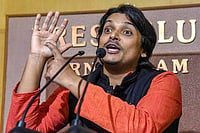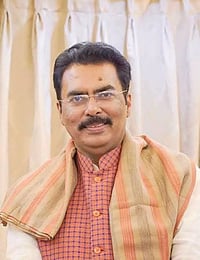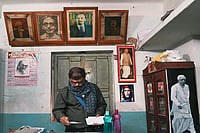SUDDENLY the thrill was back. Here was Zaheer Khan, a 22-year-old engineering drop-out from Baroda, snorting down the track, looking the adversary in the eye, yorking two Kenyan batsmen on the trot, and pumping his wrist in the air in his international debut. Here was Yuvraj Singh, a 19-year-old arts student from Chandigarh, hammering his maiden international half-century off 47 balls with the chutzpah of a hardened veteran. This was en route a scorching 84 off 80 balls. Here was an inspired veteran Venkatesh Prasad scooping South Africa's Roger Telemachus out of thin air with an amazing spot-jump at deep square leg. And most importantly, here was Saurav Ganguly, emerging as a gritty and outspoken helmsman, working the team, admonishing and motivating the youngsters and leading from the front with two centuries in four matches.
In the heart of African safari (a Swahili word which literally means journey) country, Indian cricket seemed to have turned a new page last fortnight. At the quaint 12,000-capacity Nairobi Gymkhana ground, the venue for the eleven-nation icc knockout trophy, the magic seem to have returned to stir a tainted and jaded game out of semi coma. So what if India failed to lift the cup, going down gamely to New Zealanders in a closely fought final. Ganguly, with more than a little help from a clutch of promising newcomers, seemed to be fashioning a much-needed resurrection of Indian cricket both on and off the field. Three emphatic wins in four matches, two of them against such redoubtable opponents as Australia and South Africa, was not a showing that Indian fans had expected even in their wildest dreams. "We had been lacking in understanding and spirit in recent times," says a buoyant Ganguly. "The team has more understanding now." (see interview).
When its 14-member team flew out to Kenya for the icc tournament, Indian cricket was at its lowest ebb. An embattled coach fighting to save his reputation had been replaced, a host of players were-and still are-under cloud for tanking games and evading tax, and skittish administrators seemed to be clueless about ways to stem the rot. No wonder the fans had lost faith in the game and its tainted players. An opinion poll conducted by website nazara.com just four months ago had 60.4 per cent of respondents saying the scandals had forever tainted cricket. Only 19.8 per cent felt the sport would ever recover.
And now, India's grand run on flat wickets in the heart of Africa seems to be changing the perception. The fans, for one, seem to be flocking back to the game, opium to some 1.2 billion people in four countries in the subcontinent: An opinion poll by cricketnext.com last week found that 66.76 per cent of the respondents would be "delighted to focus again on cricket." After the wins in the first two matches, 65.53 per cent of the respondents felt that India had turned the corner and is once again ready to take on the world. Among the nation's TV-watchers, the game seemed to be staging a comeback. Television rating points (trp)-which initially hovered around 1.4 and 2.1 in the first two matches, increased dramatically to 14.5 and 17.9 in the last two. This was better than the last Pepsi Cup between India and South Africa earlier this year when trps hovered around 8. Says Pepsi vice-president Deepak Jolly: "The issue of match-fixing was temporary. Nairobi has once again rekindled interest in the game."
The Indian team itself basked in its newfound confidence: the 11 players were unchanged throughout the four matches they played. India's batting strength also looked redoubtable-in none of the four matches was the team bowled out. The Indians lost 23 wickets in all, but a rejuvenated bowling side also claimed 35 scalps of the opponents. It also walked away with laurels effortlessly-in three of the four games, Anil Kumble, Yuvraj Singh and Saurav Ganguly won the man of the match awards. "The overall performance was terrific," says Ashok Malhotra, selector and former Test opener. "It was the right kind of injection our cricket needed."
The injection was largely admininstered by a troika of exciting young debutants. Yuvraj Singh, the swashbuckling all-rounder from Punjab (the son of one-Test paceman Yograj Singh), was the find of the tourney-an aggregate of 143 runs in four games at an average of 47.66. This included his scintillating 84 against Australia. Naturally strong off his legs, Singh whacked the likes of Brett Lee and Glenn McGrath with consummate ease. As if to prove his sheer attitude, he also clubbed White Lightning Allan Donald for three successive boundaries in the semi-final en route an exciting cameo of 41, which included six boundraies. And then he capped it all with some nifty fielding-Michael Bevan's run out by his direct hit was an exceptional piece of cricket by an international rookie. "Only Yuvraj was the genuine new find not only in batting and fielding, but also in bowling," says Bangalore-based veteran cricket writer T.G. Vaidyanathan.
Not surprsingly, Singh's seniors are singing paeans in his praise now. Skipper Ganguly is impressed by the youngster's joie de vivre: "His attitude is infectious. It rubs on other team-mates as well." Agrees former Indian captain and selector Ajit Wadekar: "Yuvraj seems to be gifted with the kind of attitude that puts him in the international class." Hanumant Singh, head of the Bangalore-based National Cricket Academy, says: "Yuvraj is an enigmatic boy. Sometimes very quiet, restricting his company to a very few. But when he goes out to bat, he gets into an attacking frame of mind. He is also very acrobatic." Former Test all-rounder Roger Binny is also lavish in his praise: "He's a good thinker. He had a tough baptism in bowling against Australia and South Africa. Yet he made a good beginning." Former Test opener Krishnamachari Srikkanth, who worked with Singh as coach of India's under-19 squad, says he knew "here was a guy who would go a long way." He adds: "He's a positive, aggressive cricketer."
Traits which the spunky left-arm debutant speedster Zaheer Khan seems to share with Singh. The strapping bowler, who is now India's quickest, picked up seven wickets in four matches. More importantly, he worked up a lively pace and betrayed an agressive body language. Khan, who's had a three-year stint honing his physique, technique and mental fitness with Chennai-based mrf Pace Foundation, impressed even the legdendary Dennis Lillee. But Mumbai-based former Test batsman Ashok Mankad reminisces that Khan seems to have begun indifferently. "When he was in the Mumbai side, he was mediocre. I didn't take him on. But today he's improved so much. And I am glad he has proved me wrong."
Even Vijay Dahiya, the 27-year-old wicketkeeper from Delhi, justified his inclusion by mopping up six dismissals with some smart work behind the stumps. "He looks confident and is good to watch," says former Test bowler and selector Shivlal Yadav. Clearly, the dawn of Indian cricket is now being ushered in by these newcomers, with some promising players waiting in the wings. (see box). "The newcomers have come with great temperament," says Wadekar.
The other high point has been Ganguly's maturing as a no-nonsense captain who's not afraid to experiment or speak his mind. The 28-year-old elegant left-hander totted up the highest run aggregate in the championship-348 runs, with two centuries and a fifty, at an average of 116.00. "The team spirit under Ganguly is wonderful," gushes former Test batsman and selector Ashok Malhotra. And Ganguly only helped his cause when he took care of his new team-mates-on field, he was always ready to chip in with precious nuggets of wisdom whenever he felt Khan was getting carried away by bowling short of good length. "It's my job to do that," he says, adding with the same determination and sincerity: "It's my duty to rectify their errors." And off the field, the captain's grit was on display when some Kenyan hacks quizzed him repeatedly whether India had fixed the final. "Didn't you see the match?," he shot back. "It was a clean game, wasn't it." Former selector Sambaran Banerjee attributes India's revival to Ganguly's gutsy captaincy: "He's pulled Indian cricket out of its crisis. Today cricket has regained the prestige that it had lost during the last six months."
That was not all. The fielding was a revelation, with the players looking more sprightly and snapping up most of the chances. "There's been a qualitative improvement in the standard of fielding thanks to the youngsters," says former Test batsman W.V. Raman. Concurs Balwinder Singh Sandhu, former Test bowler: "The newcomers know that India have always lagged behind in the fielding department. So they have brought their attacking mindset to the field too. Most importantly, the boys also look very fit."
Of course, not all is hunky dory still. For one, India's bowling attack is still not cutting edge, despite Venkatesh Prasad's sterling performance-he claimed the most number of wickets in the tourney with eight victims at a rate of 21.37 per wicket-and a consistent Anil Kumble. Writing in go4cricket.com, former Indian captain Mansur Ali Khan Pataudi cautions that Zaheer Khan will have to learn to be more "subtle". Former captain Bishen Singh Bedi feels the euphoria after Nairobi is much ado about nothing. "After all, we didn't win the cup," he says. The legendary spinner feels that Sachin Tendulkar "never really looked to be in rhythm except in the last match", and Vinod Kambli and Ajit Agarkar "never looked to be a part of the team." Former Test player Brijesh Patel also didn't find anything "special" about the team. "There were a couple of brilliant performances," he says, "but there was no consistency." Patel says he was vexed by the batting order changes, and the fact that Prasad was not allowed to bowl his entire quota of overs. "And what is Ajit Agarkar's role in the team? A lucky mascot?," he wonders. Pataudi sums up the sentiment with characteristic candour: "Indians will have to score at least six runs an over in their 50 overs and replace enthusiasm with a bit more skill on the field, if they don't want to get pipped at the post."
Ex-cricketers also insist that domestic cricket should be marketed more aggressively and players awarded on a better scale to spawn international talent, upgrade training facilities, and a variety of pitches should be prepared. There is also a crying need for a couple of genuine all-rounders.
But, all said and done, optimism and sensible thinking seems to be coming back to Indian cricket. Possibly the biggest bonus in Nairobi is the team basking in a newfound camaraderie. Senior members confided that the national teams of the past used to have at least three players whose "objective looked dubious at times and the team image was far from their minds." In Nairobi, there were none of these-the players shared the same floor, and during practice, the bonhomie was unmistakable: the players looked a happy lot, pushing and driving each other to the hilt. There were no curfew hours and stiff regulations. "We can't behave like headmasters," mused Ganguly. "The boys know their job and we don't have to discipline them. Let them enjoy."
Clearly, the confidence crisis which Indian cricket was afflicted with not too long ago seems to be over for the moment. Allegations of match-fixing had caused a significant dent in the annual figure of brand endorsements, match fees and prize monies that totalled a whopping Rs 210 crore last year. Birla Yamaha dropped Ajay Jadeja from their commercials. Hindustan Lever Limited (hll) continues to shun Jadeja's CloseUp campaign. His United Breweries Kingfisher campaign is also off the tube. Actress Tabu replaced Kapil Dev in this year's Samsung commercials. "But that is slowly changing," says Jolly. And how. A television company covering the Nairobi tourney saw a sudden swing in its fortunes within hours of India's stunning win over Australia. Advertising slots that had gone vacant for the opener against Kenya were quickly snapped up.
But for the spirited show in Nairobi and a turnaround in the team's sullied image, one swallow doesn't make a summer. The same squad flew into Sharjah last week to kick off the triangular series, where Sri Lanka and Zimbabwe are the other teams in the fray. In an age of telegenic stars and illusory truimphalism, a resounding victory at Sharjah would be the perfect antidote to shrug off its unsavoury past. "India's performance in Nairobi has been a revelation," says the usually circumspect Arun Lal, former Test opener. "Hopefully this should prove a turning point." Hopefully.
With Soumitra Bose (go4cricket.Com) In Nairobi, Bobby John Varkey & Shantanu Guha Ray In Delhi, B.R. Srikanth In Bangalore, Ashis K. Biswas in Calcutta


























